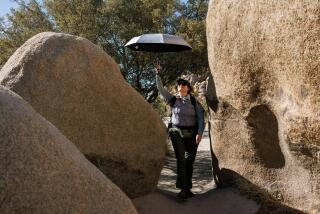Taking the Kids : National Parks for Junior Rangers
- Share via
“They’re just a bunch of big, old trees,” Reggie grumbled. “Can we leave now?”
“Boring,” Matt agreed. We were walking along a paved trail at Muir Woods National Monument just north of San Francisco looking at the giant redwoods. The towering trees, some more than 200 feet tall and more than 1,000 years old, were spectacular. But just seeing them wasn’t enough to keep an active 10-year-old and his 8-year-old sister, Reggie, interested. Even worse, the level path we were following was much too tame to offer a hiking challenge.
I really blew it. We could have had a terrific afternoon exploring had we known about the free discovery pack distributed at the visitor center. The kid-size backpack comes complete with binoculars, magnifying lens, ruler, paper and pencil, bug box, net and a list of activities that would have kept my children happily involved for hours, teaching them about the forest in the bargain.
There were far more challenging hiking routes we could have taken. But I didn’t know about them or the free packs because I hadn’t asked at the visitor center when we’d arrived. I was in too great a hurry to get going.
Many families who visit national parks have the same problem, rangers say. “People want to see the park in five minutes. It would be nice if they slowed down. They’d get much more out of the experience,” said Allison Campbell, who oversees education programs at Muir Woods. Campbell said that the park gets 1.6 million visitors a year, yet only 600 used the discovery packs last year. And many of those came with school groups.
“We see a lot of exhausted kids and exasperated parents,” agreed Candice Tinkler, education specialist for the Grand Canyon.
But it doesn’t have to be that way. National parks today are reaching out to children and families with an array of special programs and activities at large parks, as well as at smaller historic sites. The Parks as Classrooms program, a joint effort of the National Park Service and its philanthropic arm, the National Park Foundation, has reached more than 1.5 million school children since it started in 1992. And plans are underway to join the popular Junior Ranger programs at many national parks into one national program with unique regional characteristics.
These efforts come at a time when aging baby boomers are searching for more active and meaningful (and, perhaps, budget) vacations to share with their kids.
*
It’s not necessary to head to the biggest and most crowded parks. “Most of the 367 national parks now offer Junior Ranger or other programs for children,” said Corky Mayo, chief of interpretation for the National Park Service.
Consider spending a day at a national historic site near your home or a weekend at one of the smaller parks around the country. The rangers are eager to show off what makes their locales special.
Ask rangers how to make the most out of a visit to their park and they’ll urge families to adopt a leisurely pace and enjoy the park, rather than racing through the day to see everything.
Better yet, let the kids do the planning. Talk about what everyone wants to do: Hike up to the top of a waterfall at Yosemite National Park in California, slide down a huge sand dune at White Sands National Monument in New Mexico, fish for trout at Glacier National Park in Montana. What animals do they want to see? The kids could even help plan which trails to hike.
Taking the Kids appears weekly.
More to Read
Sign up for The Wild
We’ll help you find the best places to hike, bike and run, as well as the perfect silent spots for meditation and yoga.
You may occasionally receive promotional content from the Los Angeles Times.






